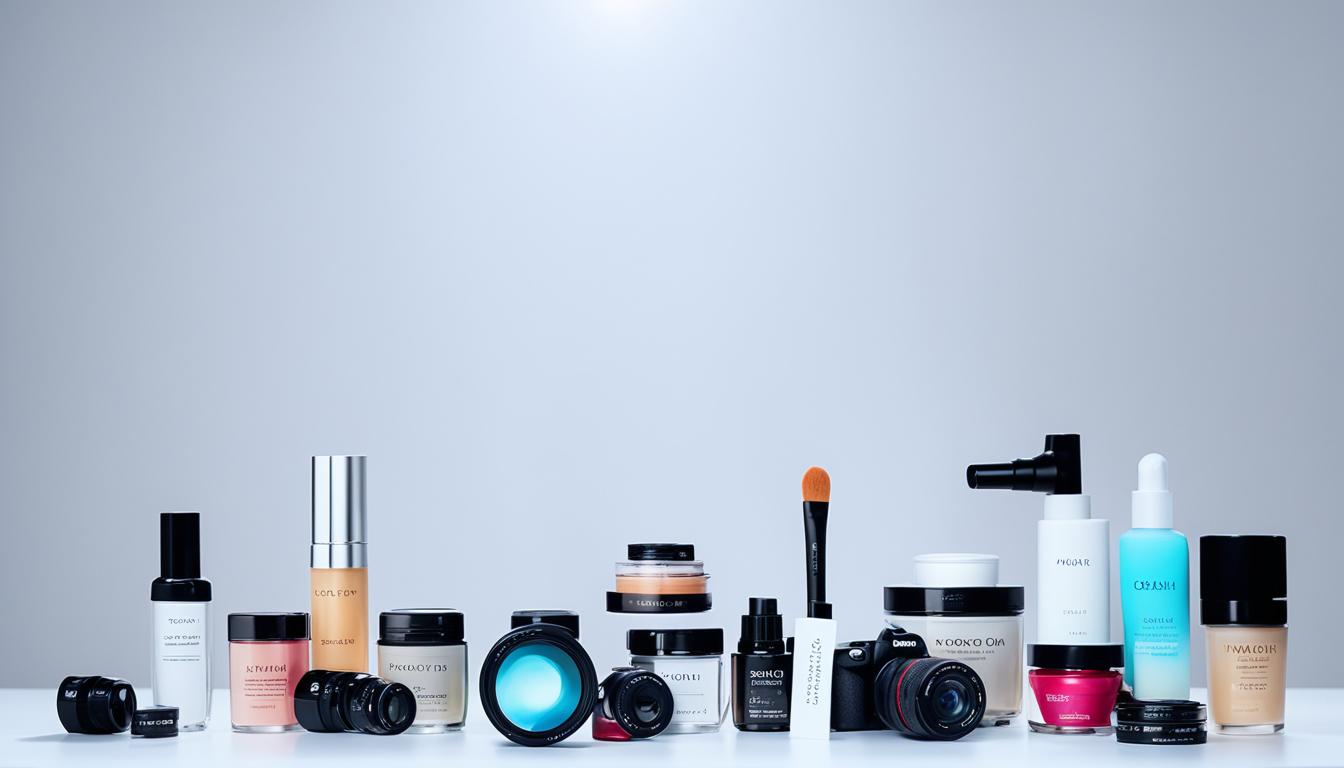As the field of product photography continues to evolve, it’s important for us to stay up-to-date with the latest trends, techniques, and innovations. Technology advancements have brought about significant shifts in visual content and photography styles, making it crucial for photographers and eCommerce marketers to adapt and stay current. By understanding and incorporating the evolving trends in product photography, we can create compelling and contemporary visuals that resonate with our target audience.
Market research in photography has identified several key trends that are shaping the industry in 2023. These trends encompass various aspects of product photography, including evolving image techniques, innovative practices, and contemporary visual aesthetics. By embracing these trends, we can enhance our photography skills and create engaging visuals that captivate consumers and drive sales.
- Product photography is constantly evolving, driven by advancements in technology and changing consumer preferences.
- Staying current with the latest trends in product photography is essential for creating visuals that resonate with the target audience.
- Understanding evolving photography styles, techniques, and aesthetic preferences is crucial for staying ahead of the competition.
- Market research helps identify emerging trends and innovative practices in the product photography industry.
- By incorporating contemporary visual aesthetics and innovative techniques, we can create compelling and engaging product visuals.
DSLR Cameras vs. Smartphones: The Shift in Photography Equipment
When it comes to product photography, the equipment we use plays a crucial role in capturing high-quality images that showcase our products in the best light. For years, DSLR cameras were the go-to choice for professional photographers, offering advantages like clearer images and more lifelike subjects. However, the rise of smartphones has brought about a major shift in the photography industry.
Smartphones have become increasingly sophisticated, offering similar features and picture quality to DSLR cameras but at a much lower cost. This accessibility has led to a decline in the popularity of DSLR cameras, especially among small businesses and startups with budget constraints. Now, anyone with a smartphone can produce stunning product photos without investing in expensive professional photography equipment.
The impact of smartphones on the industry cannot be ignored. The rise of smartphones has not only changed the way we capture and share photos but has also democratized professional photography, making it more accessible to newer businesses. Small businesses can now compete with larger companies when it comes to visual content marketing without breaking the bank. This shift has leveled the playing field and opened up opportunities for individuals and smaller brands to showcase their products professionally.
“Smartphones have democratized professional photography, making it more accessible to newer businesses.”
However, it’s important to note that DSLR cameras still have their place in the industry. They offer advanced features and functionalities that smartphones might not be able to match, particularly when it comes to professional settings and specialized photography techniques. For photographers who require precise control over every aspect of their image, DSLR cameras remain the preferred choice.
Ultimately, the shift towards smartphones as a primary photography tool highlights the importance of adapting to new technologies and embracing their potential. As photographers and businesses, we need to stay up-to-date with the latest advancements in photography equipment to effectively meet the demands of our industry and create compelling visual content.
“The rise of smartphones has opened up opportunities for individuals and smaller brands to showcase their products professionally.”
Comparison Table: DSLR Cameras vs. Smartphones
| DSLR Cameras | Smartphones |
|---|---|
| Advantages: | Advantages: |
|
|
| Best Suited For: | Best Suited For: |
|
|
The Rise of Videos in Product Promotion
Videos have emerged as a powerful tool in product promotion, revolutionizing the way businesses showcase their offerings. Today, customers prefer videos because of their ability to engage and convey information effectively, surpassing the impact of static images. As a result, product photographers now need to expand their skills to include videography and incorporate product shots into their videos.
Visual storytelling has become a critical aspect of marketing strategies, with videos offering a more immersive and captivating experience for consumers. Through videos, businesses can demonstrate the features, benefits, and uses of their products in a concise yet compelling manner.
However, while videos have gained significant traction, it is important to note that product images still play an essential role in marketing. To strike a balance, photographers and eCommerce marketers must find innovative ways to seamlessly integrate product shots into their videos. Whether through strategic product placements, overlay images, or visual effects, the incorporation of product shots helps maintain the connection between the product and the viewer, reinforcing its relevance and desirability.
Visual content is undeniably influential in shaping consumer preferences and purchasing decisions. High-quality videos combined with impactful product shots create a comprehensive promotional package that captures attention and ignites interest in potential customers.
“Videos have become a game-changer in product promotion by enabling businesses to tell stories that resonate with consumers, bringing products to life in a way that static images cannot.”
With the rise of social media platforms and the increasing popularity of video content, businesses must recognize the importance of incorporating videos into their marketing strategies. By doing so, they can connect with their target audience on a deeper level and leave a lasting impression.

The Benefits of Videos in Product Promotion:
- Enhance engagement and captivate viewers
- Showcase product features and benefits effectively
- Convey brand messages and storytelling elements
- Create a memorable and immersive experience
- Increase brand awareness and reach
The Impact of Mobile Shopping on Photography
The surge in mobile shopping has revolutionized the way photographers approach their craft. With mobile devices becoming the primary platform for online shopping, it is essential for photographers to adapt their techniques to cater to this mobile-oriented market.
One of the key considerations when photographing for mobile use is the limited screen space. Mobile devices typically have smaller screens compared to desktop computers, which means photographers need to be mindful of how their images appear on these screens. Vertical pictures have become increasingly popular as they make better use of the limited screen real estate, allowing viewers to see more details without excessive scrolling.
Furthermore, photographers must optimize their images for mobile devices to ensure optimal viewing experience. Mobile-optimized images are usually compressed and resized to reduce file sizes without sacrificing image quality. This optimization process helps improve load times and ensures that the images load quickly and smoothly on mobile devices, enhancing the overall shopping experience for mobile users.
Here’s an example of how mobile-optimized images can enhance the shopping experience for mobile users:
“Mobile-optimized images have made a significant impact on our website’s performance. The fast-loading images retain their quality, and our customers appreciate not having to wait for the images to load. It has undoubtedly contributed to our increased mobile conversions.” – John Smith, eCommerce Manager
To cater to the mobile shopping trend, photographers also need to consider the unique characteristics and preferences of mobile-oriented photography. The limited screen space requires photographers to focus on capturing attention-grabbing compositions that maximize impact in a smaller frame. This includes utilizing bold colors, incorporating negative space, and experimenting with creative angles to create visually engaging images.
By embracing mobile-oriented photography, photographers can not only satisfy the needs of mobile shoppers but also differentiate themselves in the competitive online marketplace. By recognizing the importance of mobile shopping and adapting their photography techniques accordingly, photographers can play a crucial role in enhancing the visual experience for mobile users and driving conversions for businesses.
The Trend Towards More Natural Looking Imagery
Consumers are increasingly drawn to authenticity in product images, preferring natural-looking imagery over heavily edited or manipulated photos. To meet this demand, photographers need to adapt their photography style to create visuals that appear more genuine and realistic.
One key aspect of achieving natural-looking imagery is to use softer lighting. By employing diffused lighting techniques, photographers can reduce harsh shadows and create a softer, more organic feel to their product photos. This approach enhances the natural textures and details of the products, giving potential customers a better sense of what to expect.
Choosing appropriate props is another vital factor in capturing natural-looking images. When selecting props, it’s crucial to consider how they complement the product without overshadowing it. The props should enhance the overall composition and create a cohesive visual story.
Minimal editing is key to maintaining the authenticity of product images. A light touch in post-processing ensures that the colors remain true to life and the final result looks realistic. Avoiding excessive editing techniques such as heavy retouching or altering the product’s appearance is essential to preserving its authenticity.
By focusing on natural-looking imagery, photographers can tap into consumers’ desire for authenticity and enhance their trust in the brand. Customers appreciate seeing products represented realistically, as it helps them make informed purchasing decisions.
“Natural-looking imagery creates a sense of trust and credibility, strengthening the bond between the brand and the consumer. It’s about capturing the essence and true qualities of the product, rather than presenting an idealized version.” – Alex Thompson, Professional Photographer
The Benefits of Natural-Looking Imagery
Embracing natural-looking imagery in product photography offers several advantages:
- Authenticity: Natural-looking images build credibility and trust with customers.
- Consistency: Maintaining a consistent photography style across different products helps establish a cohesive brand identity.
- Engagement: Authentic visuals resonate with customers on an emotional level, increasing engagement and connection with the product.
- Conversion: Realistic product images provide customers with a clearer understanding of the product, potentially leading to higher conversion rates.
To illustrate the impact of natural-looking imagery, we can compare two product images:
| Image A | Image B |
|---|---|
 |
|
| The image is brightly lit, with vibrant colors and heavy editing. It looks stylized and overly perfected. | The image features softer lighting, minimal editing, and realistic colors. It presents the product in a more authentic and natural way. |
As we can see, Image B with natural-looking imagery presents the product in a more genuine and relatable manner, enhancing the overall customer experience. This approach aligns with the current trend towards authenticity in product images.
The Growing Popularity of 360-Degree Photography
360-degree photography is on the rise, captivating consumers on social media platforms and eCommerce websites like Amazon. This immersive photography trend allows customers to experience products from all angles, providing a more engaging and interactive shopping experience.
With 360-degree photography, customers can explore products as if they were physically present, enhancing their understanding and confidence in the product’s features, design, and quality. This immersive experience fosters a deeper connection with the product, leading to increased engagement and an improved likelihood of making a purchase.
The benefits of 360-degree photography go beyond customer engagement. Brands that incorporate this innovative photography technique into their marketing plans often gain a competitive edge. By showcasing their products in an immersive and interactive way, brands can differentiate themselves in a crowded marketplace and attract potential customers who are seeking a more engaging and memorable shopping experience.
Furthermore, 360-degree photography has the potential to impact larger products beyond traditional retail. Companies in the real estate and commercial property sectors can leverage this technology to provide virtual tours, allowing potential buyers or tenants to explore properties remotely. This immersive experience gives them a better sense of the space, enabling them to make more informed decisions.
The Benefits of 360-Degree Photography
360-degree photography offers several key benefits for brands:
- Enhanced product engagement: Customers can interact with products, rotating them 360 degrees for a comprehensive view. This deeper engagement can lead to increased time spent on product pages and a higher likelihood of conversion.
- Greater product confidence: Seeing a product from all angles instills confidence in its design, quality, and features. Customers feel more informed about their purchase, reducing the chances of returns or dissatisfaction.
- Improved customer experience: The immersive nature of 360-degree photography enhances the overall shopping experience, creating a memorable and enjoyable interaction with the brand.
- Competitive advantage: By embracing the latest photography trends like 360-degree photography, brands can differentiate themselves and stand out in a crowded marketplace, attracting and retaining customers.
As 360-degree photography continues to evolve and become more accessible, its integration into marketing plans will become increasingly critical for brands aiming to deliver a compelling and immersive product experience.
Conclusion
The world of product photography is constantly evolving, driven by advancements in technology and changing consumer preferences. Staying current with the latest trends in the product photography industry is essential for businesses to captivate consumers and stay ahead of the competition.
As technology continues to advance, photographers and eCommerce marketers must adapt to the evolving landscape. From the rise of smartphones and the importance of mobile-optimized images to the integration of video content and the trend towards more natural-looking imagery, staying up-to-date is key.
Visual content marketing plays a crucial role in connecting with consumers and driving sales. By embracing the advancements in product photography and utilizing innovative techniques, businesses can create compelling visual content that resonates with their target audience.
As the industry continues to evolve, it’s important for photographers and eCommerce marketers to conduct market research, stay informed about consumer preferences, and continuously refine their skills. Staying current with the evolving trends and advancements in product photography technology will allow businesses to effectively market their products, deliver an exceptional visual experience, and achieve success in the competitive world of eCommerce.
FAQ
What are some important trends in product photography?
Some important trends in product photography include the rise of smartphones as a popular photography tool, the increasing use of videos in product promotion, the need for mobile-optimized images, the trend towards more natural-looking imagery, and the growing popularity of 360-degree photography.
How has the popularity of smartphones impacted product photography?
Smartphones have become more sophisticated and can now produce high-quality product photos at a lower cost. This has led to a decline in the popularity of DSLR cameras, especially among small businesses and startups. The rise of smartphones has made professional photography more accessible to newer businesses.
Why are videos becoming more popular in product promotion?
Videos provide a more compact and engaging way to showcase products. They are preferred by customers for their ability to retain information better than static images. Product photographers now need to branch out and become skilled in videography to meet the demand for high-quality product shots.
How has mobile shopping impacted product photography?
With limited screen space on mobile devices, vertical orientation and mobile-optimized images have become crucial. Photographers need to ensure that their images look perfect on mobile screens and adapt their photography styles accordingly. By capturing and editing images with mobile use in mind, photographers can enhance the shopping experience for mobile users.
What are some trends in product imagery style?
Consumers are increasingly drawn to authenticity in product images, preferring natural-looking imagery over heavily edited or manipulated photos. To achieve this, photographers should focus on using softer lighting, choosing props that complement the product without overshadowing it, and avoiding excessive editing.
Why is 360-degree photography gaining popularity?
360-degree photography allows customers to have a more immersive experience by viewing products from all angles. It offers numerous benefits for brands, such as increased engagement, more confidence in the product, and ultimately, increased sales. This trend is expected to continue growing and may impact larger products like buildings and commercial properties.
How Can I Stay Up to Date with the Latest Product Photography Trends While Building My Portfolio?
To craft your product photography portfolio, it’s crucial to stay updated on the latest trends. Follow industry leaders on social media, attend workshops and webinars, and keep an eye on popular photography blogs. Experiment with different styles to showcase your versatility and adaptability in your portfolio.




